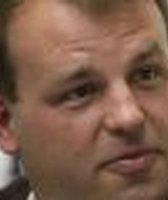Stand up for the facts!
Our only agenda is to publish the truth so you can be an informed participant in democracy.
We need your help.
I would like to contribute
Gov. Chris Christie’s State of the State address touched on some new ideas and returned to some old ones -- including one claim that earned him a Pants on Fire on the Truth-O-Meter.
In the annual speech at the Statehouse in Trenton, the governor on Tuesday called for lower taxes, education reform and changes to the criminal justice system.
Here, PolitiFact New Jersey reviews several claims from Christie's speech that are similar to ones we’ve previously tested on the Truth-O-Meter.
‘Budget Deficits’
The state was in poor fiscal shape two years ago, Christie said.
"When I raised my hand to take the oath of office then, I could not say with confidence that the state would meet its payroll within two months. Imagine that, New Jersey unable to meet its payroll. That was the gravity of the mess we were left with due to the mismanagement which reigned in this town before our arrival," Christie said. "Our deficit for that fiscal year, already more than half over, was more than two billion dollars. The budget problems for the next year, fiscal year 2011, were a record deficit of $11 billion."
We checked a similar claim last fall. Christie said in a September speech at the Ronald Reagan Presidential Library in California that his administration balanced "two budgets with over $13 billion in deficits without raising taxes." We rated that statement Half True.
Technically, yes, Christie overcame $13 billion in deficits to balance two budgets, as he is mandated to do. However, a large chunk of that figure includes a projected structural deficit: basically the difference between state revenues and the amount needed to maintain spending levels and fully fund every program required by state law.
Christie touts his fiscal accomplishment in 2011 by citing the structural deficit, which was put at $10.7 billion for that year. But in this fiscal year he dismissed the structural deficit -- estimated to be $10.5 billion -- as "the old way of budgeting."
David Rosen, the budget and finance officer for the state’s Office of Legislative Services, which calculated the structural budget deficits, told us in September that the executive branch appears to be using two different methodologies.
"I don’t know what the right answer is, but it does seem like adding apples and oranges if they are using that calculation for one year and not another," he said.
‘Private-Sector Jobs’
As evidence that New Jersey’s comeback has begun, Christie also pointed to how his administration has overseen the addition of new private-sector jobs.
"Since our administration came into office, New Jersey has added over 60,000 new private-sector jobs," Christie said. "Remember, in 2009, the year before we came into office, New Jersey lost 117,000 jobs."
We checked the claim about the new 60,000 private-sector jobs as it was presented in a video released by the governor’s office before the State of the State address. Based on the latest seasonally adjusted data from the state Department of Labor and Workforce Development, Christie’s numbers are solid.
Compared with February 2010 -- Christie’s first full month in office -- New Jersey saw an increase of 62,100 private-sector jobs as of November 2011.
Christie also is on target with the claim about private-sector job losses in 2009. Between December 2008 and December 2009, the state lost 117,700 private-sector jobs, according to state labor statistics.
But in our three previous rulings on Christie’s claims regarding about private-sector job growth, we’ve noted that the governor can’t fully take credit for those gains. One expert, Kim Rueben of the nonpartisan Urban Institute-Brookings Institution Tax Policy Center, told us in August: "It isn’t clear a specific governor can take a lot of credit for the new jobs."
Those claims have received Half True rulings from the Truth-O-Meter.
‘Newark Graduation Rate’
Newark’s high school graduation rate is a go-to line for the governor to emphasize the need for education reform in New Jersey. He repeated the claim in his State of the State address and again cited it incorrectly.
"And let’s face this fact: more money does not necessarily lead to a better education. Today, in Newark, we spend $23,000 per student for instruction and services. But only 23 percent of ninth graders who enter high school this year will receive high school diplomas in four years," Christie said.
PolitiFact New Jersey has assessed this claim, in one form or another, three times. Most recently, we set the governor’s Pants on Fire for repeating the erroneous graduation statistic.
The four-year graduation rate in Newark is 55 percent, not 23 percent. Christie’s figure represents only those students who graduate after passing the High School Proficiency Assessment, a state standardized test.
But students can graduate through alternate routes. For example, students can take a different exam and receive a high school diploma. Critics argue the alternate exam isn’t adequate, but it is still a state-approved method of graduation.
Therefore, it’s wrong to say less than a quarter of Newark freshmen will graduate in four years.
In a November ruling that checked per-pupil spending costs in Newark, PolitiFact New Jersey found measures of per-pupil expenditures vary, depending on what’s included in calculating the total and other factors.
A calculation by the state Education Department that accounts for transportation costs, debt payments and other factors showed Newark spent $22,992 per student for the 2009-2010 school year. That’s about $23,000 per student, as Christie said.
‘State Aid for Abbott Districts’
After repeating the line about the Newark graduation rates and per-pupil spending in the Brick City, Christie went on to lambast court decisions that have sent more state funding to Newark and other former Abbott districts.
"It is time to admit that the Supreme Court’s grand experiment with New Jersey children is a failure," Christie said. "Sixty-three percent of state aid over the years has gone to the Abbott districts and the schools are still predominantly failing."
We previously checked a similar claim made by Christie on Nov. 18 at the University of Notre Dame, when he said "we give 31 (former Abbott) districts 70 percent of the aid."
Christie’s statement during the State of the State address closely follows our previous research on the subject. As we discovered, the former Abbott districts are set to receive about 60 percent of the state aid in the 2011-12 school year.
Hear anything that needs checking?
We’ll be analyzing the governor’s speech and publishing fact-checks in the coming days. If you heard a fact you think is worth putting to the Truth-O-Meter, email PolitiFact New Jersey at [email protected].
You can also join the conversation about this story at NJ.com.
Our Sources
Chris Christie delivers 2012 State of the State address, Jan. 17, 2012
PolitiFact New Jersey, Chris Christie claims he balanced two budgets while facing $13 billion in deficits and didn’t raise taxes, Oct. 2, 2011
PolitiFact New Jersey, Chris Christie repeats misleading statistic on Newark’s high school graduation rate, Jan. 5, 2012
PolitiFact New Jersey, Chris Christie says graduation rate, spending levels in Newark public schools show the ‘model is broken,’ Nov. 17, 2011
PolitiFact New Jersey, Chris Christie claims 31 former Abbott districts receive 70 percent of the state aid, Dec. 1, 2011
PolitiFact New Jersey, Chris Christie touts accomplishments in video previewing State of the State address, Jan. 17, 2012
New Jersey Department of Labor and Workforce Development,New Jersey Nonagricultural Wage & Salary Employment: 1990 to 2010 (Seasonally Adjusted), accessed Jan. 17, 2012









































